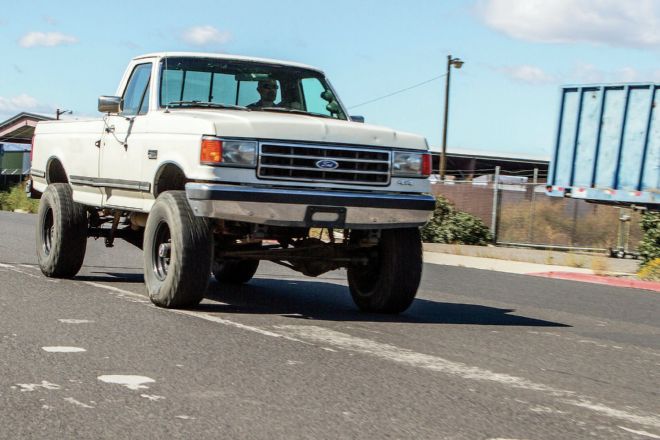
 Harry Wagner
Contributor
Harry Wagner
Contributor
Big tires are sexy. Lift kits are sexy. Brakes? Brakes are not that sexy. You can’t see them, and if things are going according to plan, most the time you aren’t using them anyway. When you do need them though, nothing else will get the job done (short of a telephone pole). And the ugly truth is that those big sexy tires increase your braking distances due to their increased weight and leverage. Fortunately, there are options out there to boost your braking, and in some instances, factory parts from other applications can even be used.
In our case, we swapped a disc-brake Dana 70 rear axle into our ’90 F-350. We also upgraded the vacuum brake booster to hydroboost using factory Motorcraft parts that we sourced through RockAuto. Discs are universally recognized for providing shorter stopping distances, weighing less, and being easier to service than drum brakes. And that is just on the pavement. Add in water or mud and the advantages of disc brakes are even more overwhelming.
The benefits of hydroboost may not be as obvious to some readers, though. Rather than relying on engine vacuum, hydroboost runs off of hydraulic pressure using the same pump and fluid as the power steering system. The hydroboost provides increased braking pressure when compared to a vacuum booster, and it works even if the engine dies or you have a diesel or lumpy camshaft that doesn’t produce much vacuum. Hydraulic boosters are also physically smaller than a vacuum booster, which is useful on applications where underhood space is at a premium due to factors like engine cages or shock mounts.
Brake Swap or Axle Swap?
Disc brake conversions are available for the Sterling 10.25 rear axle under the rear of our F-350. This is a good axle for wheeling, with a large ring gear, 35-spline axleshafts, and full-floating hubs. Disc brakes became standard on the Sterling axle in ’99 when Ford introduced the Super Duty models, but they also changed to a wonky 8x170mm bolt pattern at that time. During a recent trip to the wrecking yard, a Dana 70 caught our eye. The axle was found under the back of an ’04 Chevy 3500 Express van, came with disc brakes, and matched the 8x6.5 bolt pattern on our F-350. The width was even right. We grabbed the entire axle and emergency brake cables for less than the cost of a disc brake conversion kit.
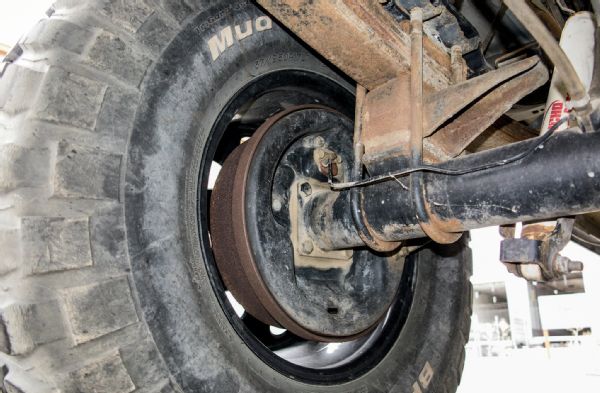 The Sterling 10.25 axle that came under our truck had served us well, but after adding 37-inch tires, the drum brakes left something to be desired. We use this truck to tow a camp trailer and a ski boat, which made the brake deficiencies even more evident.
The Sterling 10.25 axle that came under our truck had served us well, but after adding 37-inch tires, the drum brakes left something to be desired. We use this truck to tow a camp trailer and a ski boat, which made the brake deficiencies even more evident.
The Dana 70 is comparable in strength to our Sterling axle, with 1.5-inch, 35-spline axleshafts, a 10½-inch ring gear, full-floating hubs, and 3½-inch axletubes. This particular axle is a “Super 70” too, which benefits from increased ribbing in the case and spanners to set the bearing preload instead of shims, just like a GM 14-bolt axle. Since the differential is so user friendly, we took the opportunity to add an Eaton Detroit Locker and 4.56 gears before swinging it under our Ford.
In stock form, the brake pedal was spongy, and the brakes were marginal at best. We found ourselves using compression braking with the manual transmission on the trail quite often when descending hills. During our braking test, the truck stopped in 180 feet, with the rear brakes locking up after the weight shifted forward on the truck. After adding the rear disc brakes, low-speed performance was much better, but the braking distances from 60-0 mph were actually worse! This was a result of not providing adequate pressure and volume to the brake caliper pistons.
Hydroboost For Increased Pressure
The brake system in our ’90 F-350 was engineered for front discs and rear drums. Yes, we said “system” and “engineered.” The wheel cylinders in drum brakes require significantly less fluid than the big piston calipers that we added. Since the new brakes required increased fluid to operate, the pedal stroke increased, which provided less confidence in panic brake situations. Drum brakes also use a residual valve to counteract the spring tension in the drum system that pulls the shoes away from the drums. The original master cylinder and brake booster in our F-350 were adequate with the addition of the rear discs but far from ideal. Fortunately, Rock Auto had an off-the-shelf solution using factory parts.
Remember where we mentioned that Ford switched to four-wheel disc brakes with the introduction of the Super Duty in ’99? We were able to retrofit a genuine Motorcraft master cylinder (PN BRMC40) designed for four-wheel discs and a hydroboost booster (PN E8TZ-2005-B) from a Super Duty on our older truck, along with the associated Gates high-pressure hoses (PN 366200 and 352810). Vacuum boosters typically put out between 1,000-1,600 psi of pressure, while hydroboost delivers between 2,400-3,000 psi of pressure to the brake calipers. We ordered the parts from Rock Auto, and they bolted right up to our firewall.
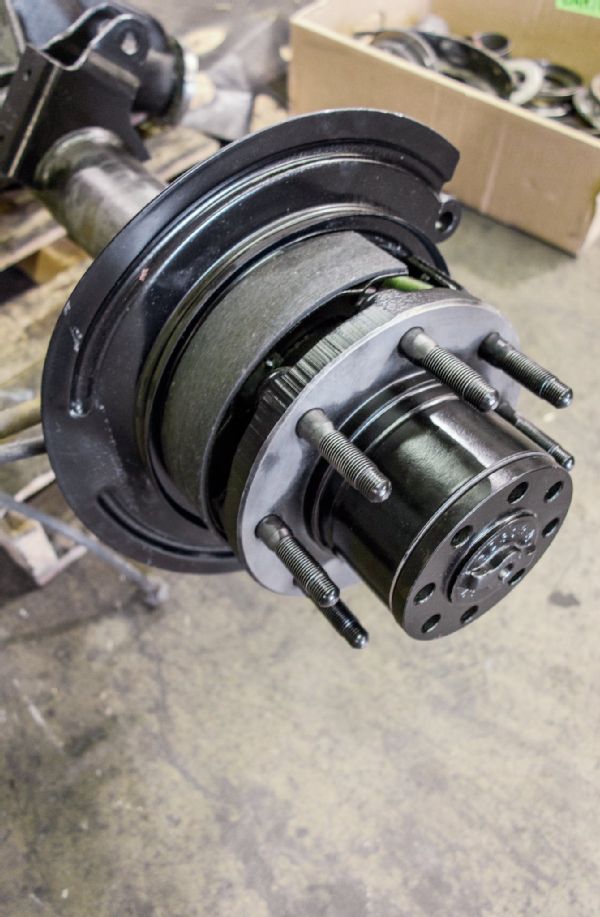
The Super 70 rear axle we swapped in uses disc brakes with a small drum inside for the parking brake. This is fairly common for trucks that use rear discs from the factory, but with swap kits, you often lose your parking brake. We got the cables when we pulled the axle, and they bolted right up.
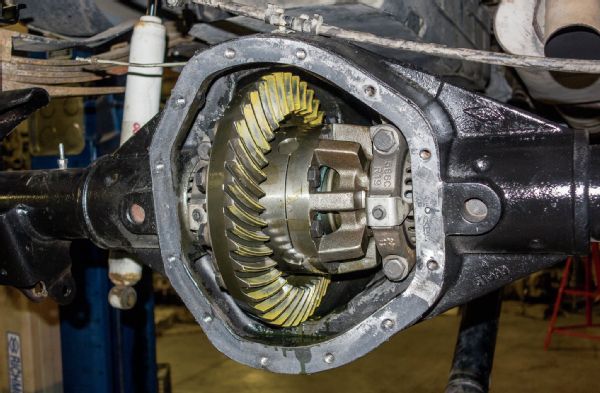
Ring gear and axleshaft size between the Sterling axle and Super 70 are comparable, but there are still some advantages to the 70, including the spanners used to adjust bearing preload (instead of shims) and the heavily reinforced housing. If we found a 14-bolt with disc brakes for the right price, that would have worked just as well.
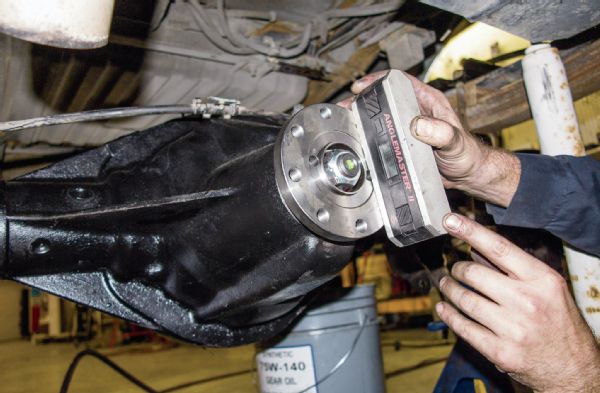
After bolting the axle in place, we measured the pinion angle before welding on the spring pads. Also note the use of a Ford flange on the pinion that we sourced from Bayshore Truck. This is the same flange found at the T-case end of our rear driveshaft, but we could have used a standard 1330 yoke to bolt up to our factory driveline.
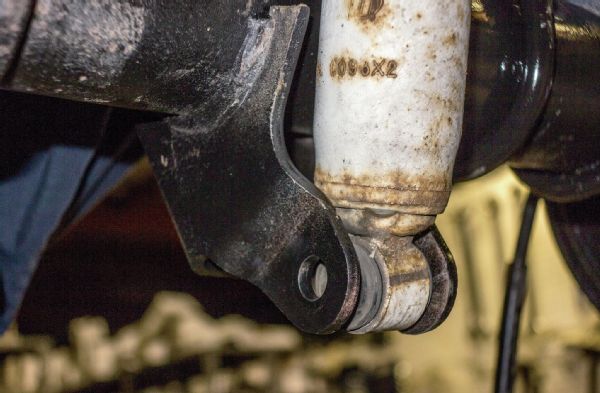
Our shocks bolted up to the mounts on the rear axle with some washers to take up the extra space. This was a useful lesson about not cutting everything off of the axlehousing early in the project, as we have often done in the past.
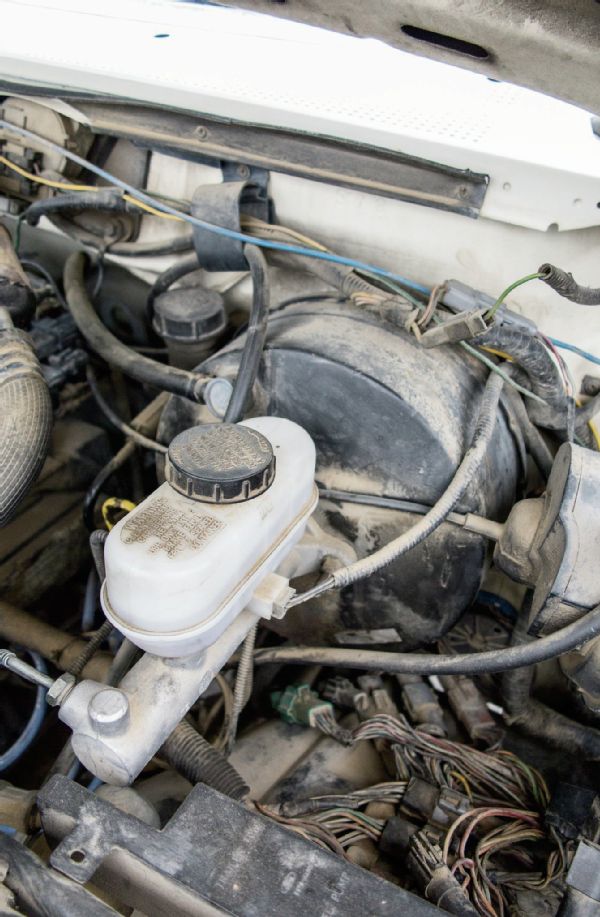
The factory master cylinder is designed for front disc and rear drum brakes. It has a 11⁄8-inch bore and uses an integrated residual valve for the rear drums. Also note the giant vacuum booster in an already crowded engine bay.
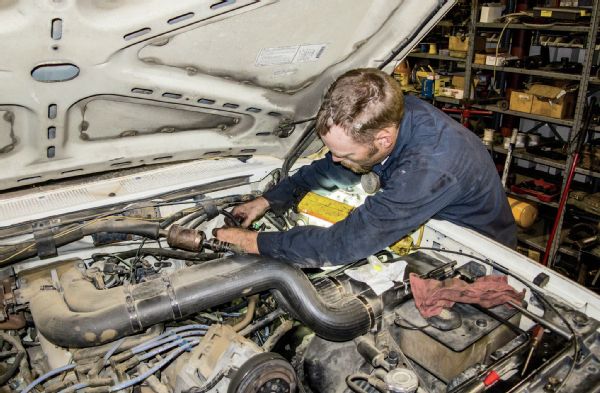
We were able to use off-the-shelf lines to plumb the hydroboost in line with our steering box. One high-pressure hose goes from the steering pump to the hydroboost, and another high-pressure line goes from the hydroboost to the steering box.
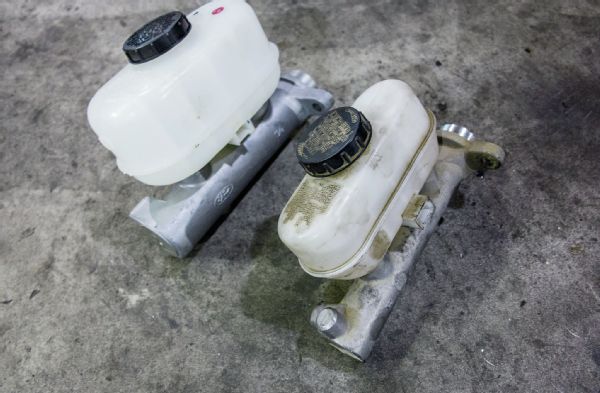
Disc-brake pistons require a higher volume of fluid to move than a drum brake wheel cylinder. The larger reservoir on the new master cylinder is designed to account for this.
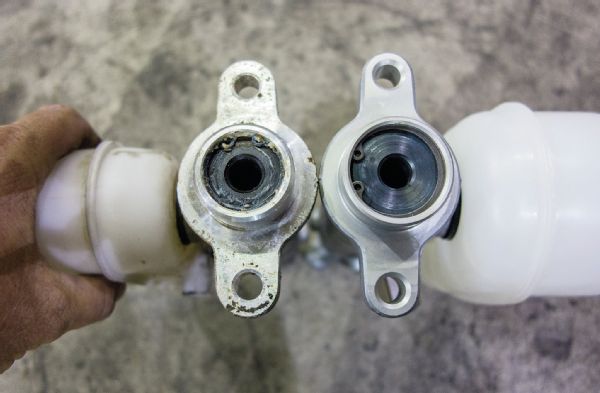
Note the larger 15⁄16-inch bore of the new master cylinder (right). This increases the volume of fluid sent to the brake calipers, but it also decreases mechanical advantage and can shorten the effective stroke of the brake pedal. This was not an issue for us, but in some instances, it may require repositioning the pivot point of the brake pedal.
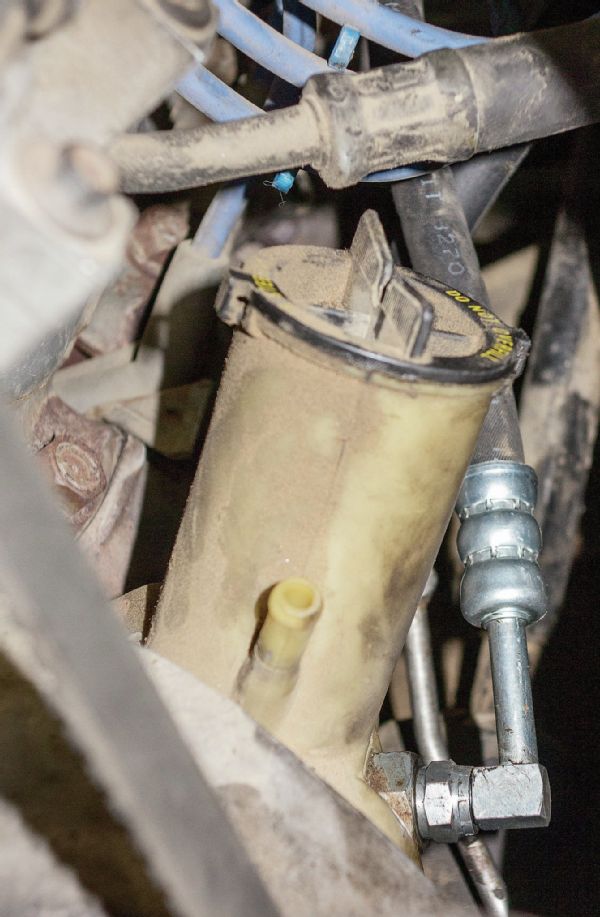
Good things come in small packages. The hydraulic booster is smaller than our old vacuum booster, yet doubles the pressure sent to the brakes. The best part is that this is a reasonably priced part that bolts right in.

We had previously added a Super Duty steering reservoir with the required nipple for the return line from the hydroboost. You can modify your factory reservoir or swap in the Super Duty reservoir like we did (PN E5LY-3A697-A).
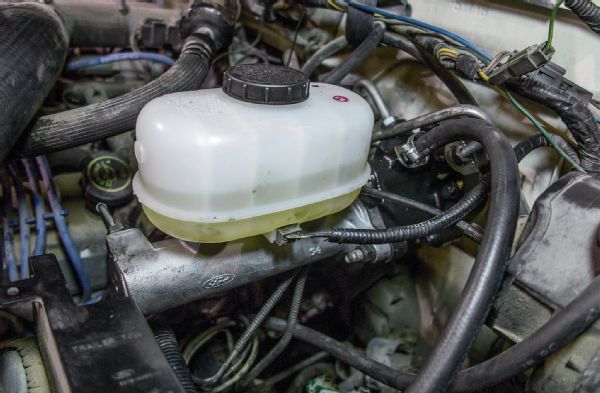
The new master cylinder and hydroboost assembly bolted right up to our firewall and existing brake lines. We used off-the-shelf high-pressure hoses to simplify the installation, but custom hydraulic lines would allow for cleaner routing in our crowded engine bay.
Hit The Road
After adding the hydroboost and new master cylinder, the brake feel was dramatically improved. Even when bleeding the brakes it was obvious how much fluid the hydroboost and master cylinder were moving, as fluid shot out of the rear bleeder when we cracked it open. The pedal is firm, and our stopping distance decreased by nearly 25 percent. The truck locks up all four tires evenly now, which is a blessing and a curse. We had become accustomed to just mashing the pedal to stop, but the boost in braking power requires a more nuanced modulation of the pedal to keep the truck in a straight line.
We performed the installation of all of these parts in a weekend but will confess that we had a two-post lift and air tools at our disposal. You could do all of this in your driveway, but it will certainly take longer, and expect there to be some cursing and scowls from neighbors along the way. The axle swap was far more involved than the hydroboost swap. You could even break it up over multiple weekends, doing the disc brakes and hydroboost separately. The biggest factor in keeping surprises to a minimum was doing research, having everything we needed on hand before we started, and using OEM parts that are affordable, reliable, and easy to source. While it may not be as sexy as big tires, our new brakes have given us a big boost of confidence on the street, in the dirt, and particularly when towing. And what is sexier than confidence?
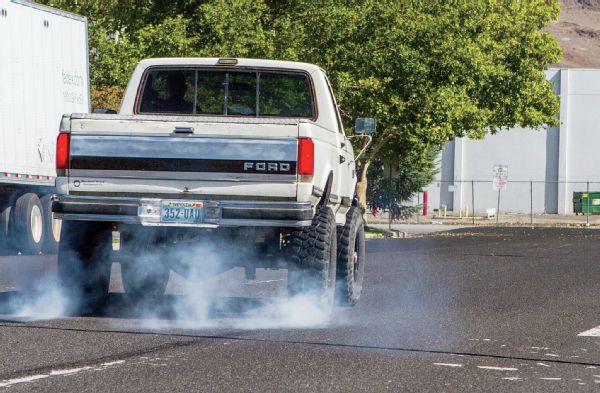 Equipped with a heavy 460ci engine up front and an empty truck bed, the weight would transfer forward when we hit the brakes. This caused the rear end to lock up prior to installing the hydroboost and new master cylinder. Now we can lock up all four tires, but we have found that modulating the pedal results in the shortest stopping distances instead of just mashing the pedal like we used to do.
Equipped with a heavy 460ci engine up front and an empty truck bed, the weight would transfer forward when we hit the brakes. This caused the rear end to lock up prior to installing the hydroboost and new master cylinder. Now we can lock up all four tires, but we have found that modulating the pedal results in the shortest stopping distances instead of just mashing the pedal like we used to do.
Braking Distances
Don’t you hate when magazines perform brake upgrades and then don’t even quantify the improvement? Yes, us too. So here are the braking distances for our ’90 Ford F-350 with 37-inch BFGoodrich Mud-Terrain KM2 tires.
Stock Disc Front/Drum Rear Brakes: 180 feet
Four Wheel Disc Brakes: 185 feet
Four Wheel Discs and Hydroboost: 145 feet